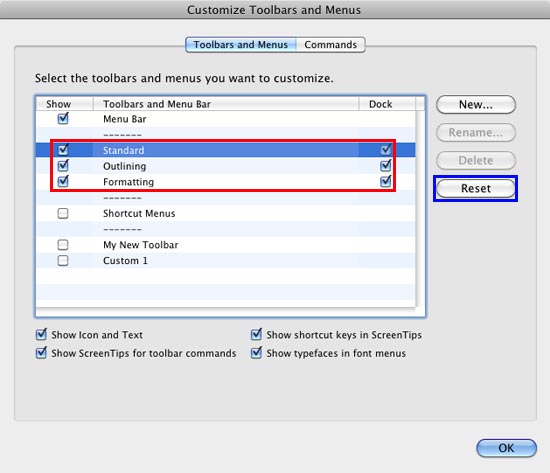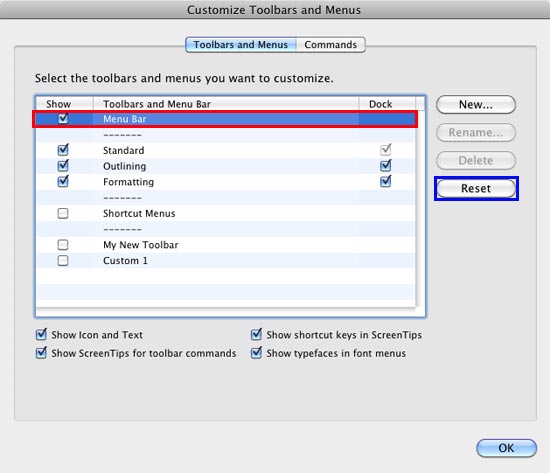The fact that you can customize options within the menus and toolbars in PowerPoint 2011 for Mac may mean that sometimes you may just get
carried away and make more changes than you intended. Or, you made some changes for an important project that's over, and now you want the menus
and toolbars to go back to their pristine, default state. Whatever your intent may be, PowerPoint's Reset option lets achieve
this default state with a couple of clicks, as we explain on this page.
Tip: Want to know more about customizations you can do to your menus and toolbars within PowerPoint
2011? Explore these tutorial pages to learn more:
Before you start, take a look at Figure 1 to get familiar with the various Toolbars and Menu interface elements within
PowerPoint 2011.

Figure 1: Menu Bar and various Toolbars within PowerPoint 2011 for Mac interface
These elements, as marked in Figure 1 above are:
- Menu Bar
- Standard Toolbar
- Formatting Toolbar
- Outlining Toolbar
Now, follow these steps to learn how to reset the customizations done to the Menu Bar and various Toolbars, and get them back to their
default status:
Reset Toolbars
Follow these steps to reset a Toolbar to its default status in PowerPoint 2011:
- Launch PowerPoint and select the View | Toolbars | Customize Toolbars and Menus
option, as shown in Figure 2.

Figure 2: Select the Customize Toolbars and Menus option
- Alternatively, you can right-click on any of the Toolbars, and select the Customize Toolbars and Menus
option from the resultant contextual menu, as shown in Figure 3.

Figure 3: Customize Toolbars and Menus option within the right-click contextual menu
- Either option brings up the Customize Toolbars and Menus dialog box. In this dialog box you can see the
Standard, Outlining, and Formatting options (highlighted in
red within Figure 4). Select the Toolbar option you want to reset, by select, we do not mean
the check mark in front of the Toolbar's name. You will actually have to click on the name of the Toolbar so that you can see the name within
a blue bar, also the text turns white. In Figure 4, you can see the Standard option selected (notice that
this is within the blue bar area). Then click the Reset button (highlighted in blue within
Figure 4).

Figure 4: Reset Toolbars within Customize Toolbars and Menus dialog box
- A window appears asking for the confirmation about resetting the selected Toolbar, as shown in Figure 5. Click
the OK button.

Figure 5: Are you sure you want to reset the Toolbar?
- This will take you back to the Customize Toolbars and Menus dialog box. Select and reset other Toolbars as
explained in steps 2 and 3. Then, click OK button within the Customize Toolbars and Menus dialog box. This
will cancel all customizations made to the selected Toolbar(s), and restore them back to the default status.
Tip: There is an alternative way to reset any Toolbar, just right-click the Toolbar to be reset, from
the contextual menu, select the
Reset Toolbar option as shown in
Figure 6.
 Figure 6:
Figure 6: Reset Toolbar option within the contextual menu
A window appears asking for the confirmation about resetting the selected Toolbar, as shown in
Figure 5 earlier on this
page. Click
OK button in this Window.
Reset Menu Bar
To reset the Menu Bar, follow these steps:
- Access the Customize Toolbars and Menus dialog box as explained in Step 1 in the preceding section of this page.
- Within the Customize Toolbars and Menus dialog box, select the Menu Bar option as shown highlighted in
red within Figure 7, and click the Reset button
(highlighted in blue within Figure 7).

Figure 7: Reset Menu Bar
- This will open a window asking for confirmation to delete the Menu Bar, as shown in Figure 5
earlier on this page. Click OK button in this Window.
- Then, click OK button within the Customize Toolbars and Menus dialog box.
This will cancel all customizations done to the Menu Bar, and restore it to the default status.







